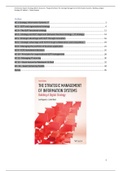Information System Strategy (Martin Goossen) - Peppard & Ward, The strategic Management of Information Systems: Building a Digital
Strategy (4th edition) - Darya Krapyva
Index
HC 1 Strategy, Information Systems, IT ................................................................................................... 2
HC 2 - IS/IT and organizational strategy .................................................................................................. 6
HC 3 – The IS/IT functional strategy ...................................................................................................... 11
HC 4 – Strategy and IS/IT alignment (between business strategy – IT strategy) .................................. 13
HC 5 - Strategic advantage with IS/IT through innovation .................................................................... 16
HC 6 – Strategic advantage with IS/IT through collaboration and competition – ................................ 19
HC 8 – Managing the portfolio of business application ........................................................................ 21
HC 9 – IT/IS investment decisions ......................................................................................................... 25
HC 10 – Principles for organizational IS/IT management ...................................................................... 28
HC 11– Managing IT sourcing ................................................................................................................ 30
HC 12 – Guest lecture by Rabobank & Shell ......................................................................................... 32
HC -13 – Guest lecture by PostNL.......................................................................................................... 34
Quizes .................................................................................................................................................... 35
1
,Information System Strategy (Martin Goossen) - Peppard & Ward, The strategic Management of Information Systems: Building a Digital
Strategy (4th edition) - Darya Krapyva
HC 1 Strategy, Information Systems, IT
Information technology (IT) - “the technology, essentially hardware, software, and telecommunications network, that facilitate the
acquisition and collection, processing, storing, delivery, sharing and presentation of information” ex. Telephone booth (to transfer
data), macbook (but also IS), Self scan
Information Systems (IS) - “the means by which people and organizations (increasingly utilizing technology) gather process, store,
use, and disseminate information” ex. Birthday calendar, flight schedule, Airbnb, Self scan
Strategy - “a coherent set of actions matching internal resources with the external environment to reach long-term objectives”
(Gartner Hype Cycle for Emerging Technologies)
A mobile phone is a combination of IS, IT, Strategy together
IT and IS are heavily integrated:
- Information systems do no longer exist without information technology
- Information technology has no use without information systems
Information Systems Strategy (Chen et al., 2010) – Context, conduct, performance - A disciplinary/functional strategy
Concerned with the role of IS/IT in organizations
- Top-down: IS/IT to use the best support a chosen business strategy
- Bottom-up: IS/IT to drive changed in business strategy
An ambiguous strategy - Source for differentiation and competitive advantage
Sullivan Matrix – Environment of IS/IT strategies (dependency on IS/IT)
Diffusion – extend of how many people using the system ↑
Infusion – degree of dependence on IS/IT of the business→
Internal Organizational Pressures – demanding further distribution of IS/IT control↑
External Competitive pressures – increasing the criticality of IS/IT to the business →
Traditional – using IT to improve efficiency on an application by application basis (policeman without phone, professional soccer
clubs (no phone during the game))
Backbone – IS/IT is critical to business operations an control (humanitarian aid (depending of the context), airlines)
Complex – too much central control to avoid poor investments will limit innovation (airport (it will be closed when a system is
down)
Opportunistic – decentralized control giving business managers the ability to satisfy their local priorities (middle and high school)
2
,Information System Strategy (Martin Goossen) - Peppard & Ward, The strategic Management of Information Systems: Building a Digital
Strategy (4th edition) - Darya Krapyva
IS/IT context (internal/external): Three-era model - How IT influences organizations in 3 areas.
The evolution of the role of information systems and technology in organizations can be described as encompassing three eras.
1. Data Processing (DP) – to improve operational efficiency by automating information flows and processes
2. Management information systems (MIS) – to increase management effectiveness by satisfying their information
requirements for decision making
3. Strategic Information Systems (SIS) – to improve competitiveness by changing the nature or conduct of business.
All firms go through all the stages, efficient/effective/competitive.
Digital Disruption – IS/IT strategy must be aware of:
1. From marketplace to marketspace (offline to online)
2. Blurring of the physical/digital divide – mix of online and offline (pick up of in the supermarket)
3. Move from push to pull economy – rather than waiting for an approach from the customer, retail seek to be proactive.
Development of (open/private) standards – applications are developed by the information availability like AirBnB
3
, Information System Strategy (Martin Goossen) - Peppard & Ward, The strategic Management of Information Systems: Building a Digital
Strategy (4th edition) - Darya Krapyva
IS/IT Conduct: Strategic Alignment model (top-down) - (Henderson & Venkatraman, 1993)
Below describes the dynamic alignment between the business and IS/IT strategic context. Their model is based on the building
blocks of strategic and functional integration. With four domains of strategic choice: business strategy, organizational
infrastructure and processes, digital strategy and IS/IT infrastructure and processes.
The Strategic alignment model (SAM) assess the range of strategic choices facing managers and explores how they interrelate.
IS/IT conduct: Prioritizing IS/IT systems (using McFarlan matrix)
Not all IS/IT investments make the same contribution to business success and therefore heir importance to the business is
likely to be quite different. McFarlan considered the overall contribution of IS/IT to the business now and in the future, based
on its industry impact.
Strategic - applications and investments are critical to future business success (Osiris)
High Potential – “” may create opportunities to gain a future advantage (Online courses (not essential for current business but
for the future)
Key Operational – “” sustain the existing business operations, helping to avoid any disadvantage. wireless internet (we need it
to make our work; if you want more students it’s strategic), Digital learning environment (blackboard, ATMs, ERP)
Support – reduce costs by increasing business efficiency, or improve management effectiveness (Google Drive, Room
reservation system)
Similar to the Boston Consulting Matrix for product portfolios
4






